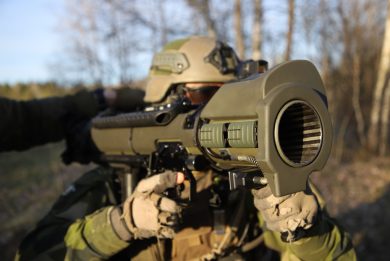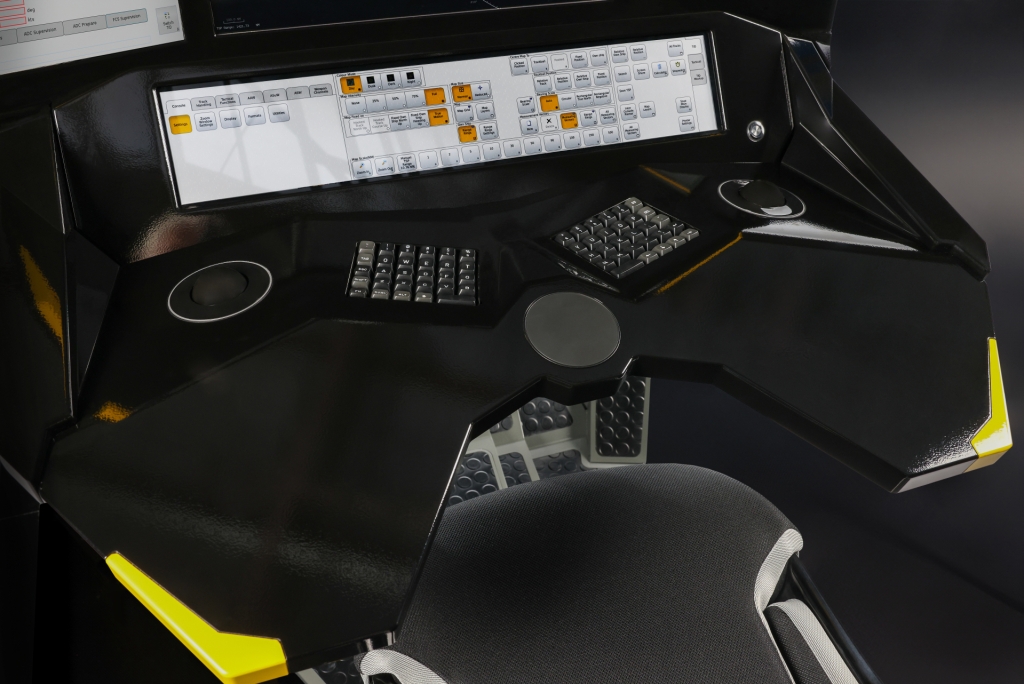
Saab will unveil a Future Operator Workspace concept for naval applications at DSEI 2023
A prototype of a Future Operator Workspace concept for naval applications will be displayed by Saab on its stand at DSEI 2023. The company has been working on the concept prototype for about two years both in Sweden and in Australia where the revolutionary combat console was built, and is now ready to work closely with global customers to seek their feedback to further tailor the operator workspace to their needs, moving from R&D to product and possibly becoming a future naval standard combat console ready for the market in a couple of years
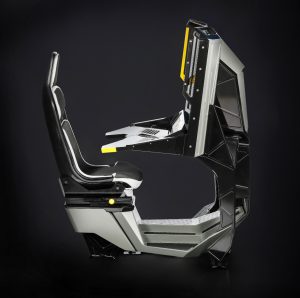
“Saab’s Future Operator Workspace is a complete evolution of the naval operator combat console and a view into the realm of what’s possible when combining a legacy of combat management expertise with design innovation and sophistication. When combined with Saab’s 9LV combat management system, the Future Operator Workspace pushes the frontier of battlespace management, increasing both the effectiveness and survivability of the naval combat operator,” Johan Hägg, Product Manager 9LV, Combat System Solutions at Saab explained during a media conference call to introduce the new concept.
Saab has a long and robust legacy of combat system hardware and software design. The 9LV combat system has been around for over 50 years providing naval forces with operational capabilities that support all types of missions. Saab’s Multi-Function Consoles (MFCs) have also existed for over five decades and are in service with naval defence forces across the globe, from the Swedish Gothenburg-class corvettes, Australia’s Anzac-class frigates, the Danish Surface Fleet, the US Independence-class Littoral Combat Ships (LCS) to Germany’s F123 combat system renewal project, Bulgaria’s Multi Mission Patrol Vessels and other applications worldwide, the latest Mk 4 iteration being available from the mid 2000s.
“Over the last five decades, we have continually evolved our MFCs to support increased effectiveness of naval operators, and we have expanded our design, development and manufacture of MFCs to leverage innovation and meet global customers capability requirements. Our consoles are now manufactured out of three countries, Sweden, Australia and Denmark,” the 9LV product manager highlighted.
“The ‘Future Operator Workspace’ combines innovation and cutting edge technology to increase operator effectiveness and survivability, and provide valuable seconds in critical situations. All this, is built on the success and proven performance of Saab’s combat management system, 9LV – providing unfailing readiness and the striking performance required to empower naval platforms and maritime missions,” he added, introducing the new concept.
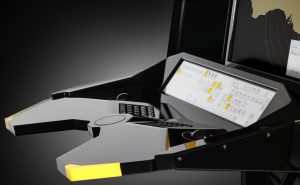
“When developing the Future Operator Workspace, Saab’s vision was to create an innovative combat operator console with new human machine interface (HMI) and hardware (HW) which delivers a new level of capability in supporting the 9LV system and enhancing combat effectiveness,” he continued.
The project was launched by Saab in 2021, based on the needs of future naval scenarios development and customers’ foreseen requirements. R&D for the platform began within Sweden while conceptualisation, development and production of the demonstrator was then transferred Australia. The prototype, which is the result of an internal company R&D funding, was built in about eight months and was recently shipped to the UK to be physically present at DSEI next week. “Two prototypes will be available, one based in Sweden and the other in Australia, for the next phase of the project which, in our plans, could take to a production version in a couple of years,” explained the 9LV product manager.
“The process was a culmination of extensive research and development, collaboration across global combat management software and hardware experts, as well as industrial design academia (both from Sweden and Australia) and, importantly, naval operators. R&D also factored in cross-defence domain solutions, inspired by Saab’s flagship products such as the Gripen fighter jet and the A26 submarine, as well as commercial and civilian applications of the most cognitively complex and demanding operations and solutions. Naval operator interviews were taken into account, as well as observation of combat management operators to help in further understanding on how we could optimise the user experience, prioritise the placement of critical components in the best possible area and operators’ field of view”, he highlighted.
“The Future Operator Workspace provides an operator immersive, intuitive platform, enabling superior management of critical systems in all operational situations. Recognising the need to enhance survivability and optimise effectiveness, the physical console was developed with human-centred ergonomics and is the first platform to fully embed the operator into the entire system,” the Saab representative explained, adding that even commercial and ‘privately-made’ game stations with seat designs were considered.
The images unveiled during the conference call show a workstation that includes not only the console itself but also the seat and legs rest, which are connected together in a single block. The seat is expected to derive from sport/games designs for improving comfort and ergonomics.
“Merging human and machine survivability, it incorporates from the 5th percentile female body type to the 95th percentile male body type, accommodating the future human,” he explained. “With its scope of technology integration, it addresses the generational spread of tech know-how. From traditional technology with a physical keyboard and trackball, to modern technology with a touchscreen and touch-gesture support, it is compliant with operators from every generation”.
A robust design, the Future Operator Workspace integrates a scope of environmental features to increase human and system survivability. “The main floor is disconnected from the operator to increase survivability during a shock event. The workstation includes an integrated shock platform to increase human/system survivability. The shock platform is also integrated into the operation room to eliminate trip hazards and provide seamless integration. It is a topology-optimised structural system, minimising footprint, without operational compromise,” he continued, adding the prototype is made in aluminium, with optional material selection to suit customers requirements. At a later stage a composite version will also be considered.
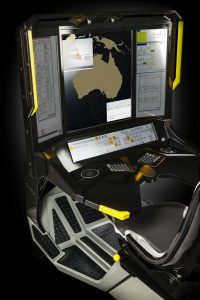
The console element includes three vertically-oriented placed displays: the central main one is a 27.6” colour tactical display (2560×2880 pixel resolution) showing the tactical situation, while the two 21,9” lateral screens (1920×720) are used for presenting information and data. The console itself is equipped with a 24” touch input display (TID) at the base of the vertically-oriented displays, which share the space with an ortholinear split keyboard with backlighting as well as two trackballs and a touchpad. The two trackballs exploit magnetic technology for consistent ball rolling force, the button touch zone features alongside trackball ‘tab to click’ capabilities in addition to full touch gestures including scroll and pinch to zoom. The touchpad features solid state sensing technology, capacitive touch sensing tracking engine, haptic and audible feedback. The workspace also includes a virtualised interface to the Tacticall integrated communication system and stereo audio. It is also equipped with a small form, yet powerful, computing platform that reduces size and weight without operational compromise. It is centred on a CPU with an Intel Core i9-12900E Processor with 30M cache (up to 5.000 GHz) and two 32 GB DDR5 4800RAM boards in addition to a NVIDIA T1000 8 GB GPU Video card. Additionally, multiple user interface options are integrated (up to 9 USB ports and up to six Ethernet ports) that can be fully customised for a tailored optimised operational experience.
Being asked about the vertically positioned displays layout and the visual interaction with the large displays positioned on combat room walls, the Saab representative explained that this layout will require adjustments to the combat operational centre, with the follow-on programme phase providing feedbacks and expected solutions.
“The Future Operator Workspace also takes software functionality of the 9LV combat management system to a new level. The immersive and intuitive HMI allows for optimised use of our bespoke software and enables new ways of interaction between the operator and the combat system, and increased functionally,” the Saab representative explained.
“The software has been crafted to adapt to the new workspace setup and large screen layout, and includes functionalities that had not be seen before, including touch gesture support. similar to the functionality you see within modern technology, swiping desktop with single finger, pinch zooming, operator preferencing for personalised setup, and search functionality, a feature that doesn’t currently exist,” he claimed.
As anticipated, the prototype will be displayed at DSEI and then at Marine Workshop in Germany in September, and at Indo Pacific in Australia in November.
“We will be working closely with our global customers to seek their feedback, so that we can further tailor the operator workspace and its future production to meet our bespoke customer needs. With satisfactory feedback, the Future Operator Workspace will move from R&D to product and possibly become our future naval standard combat console.”
Images courtesy Saab

